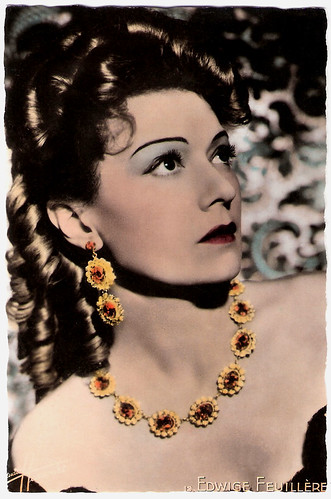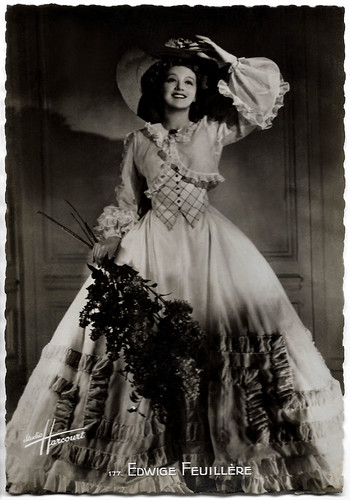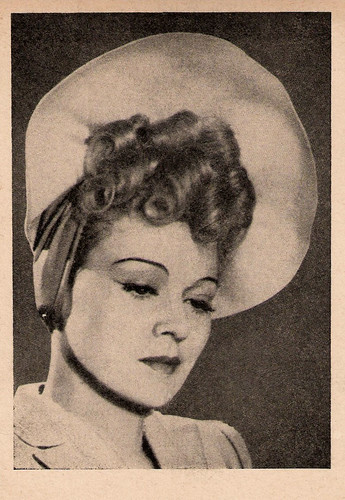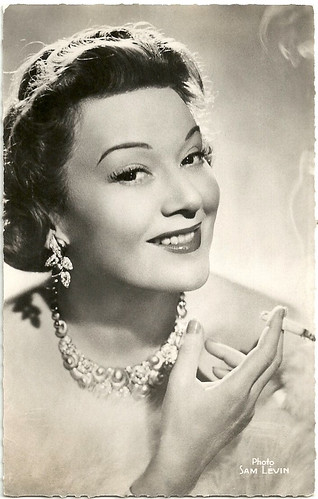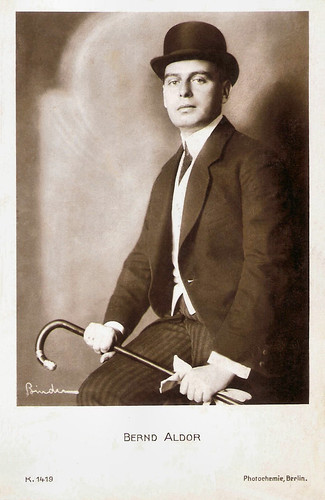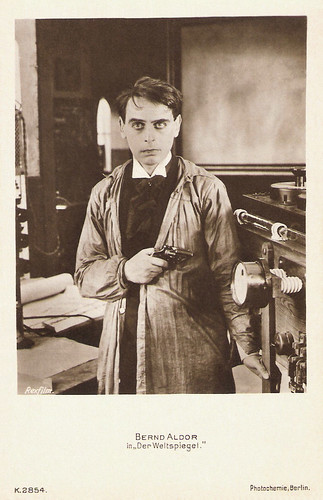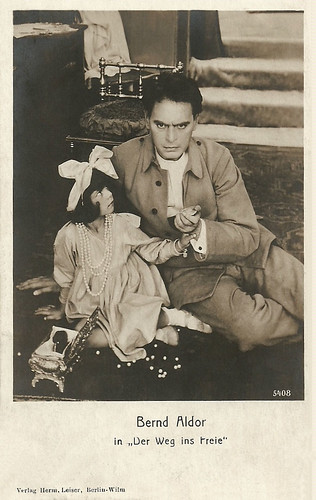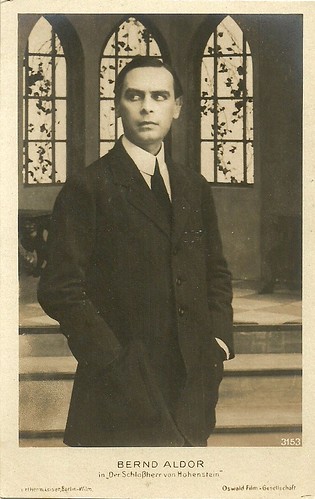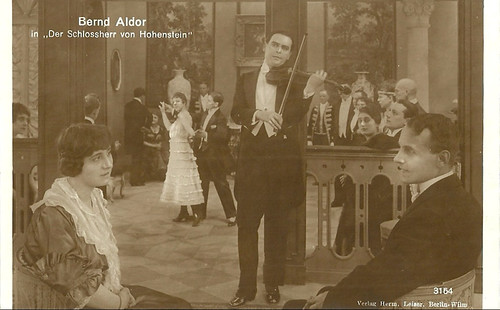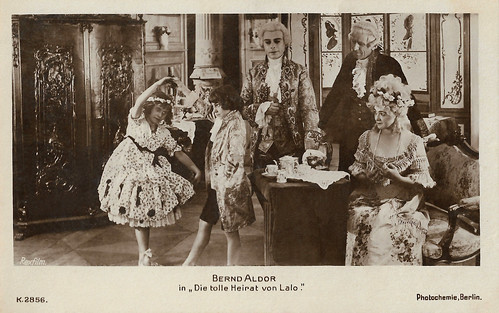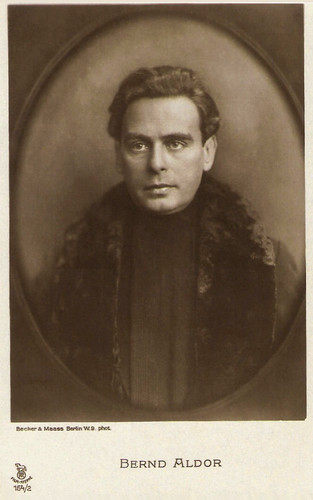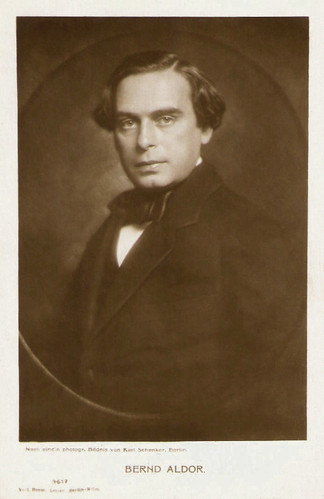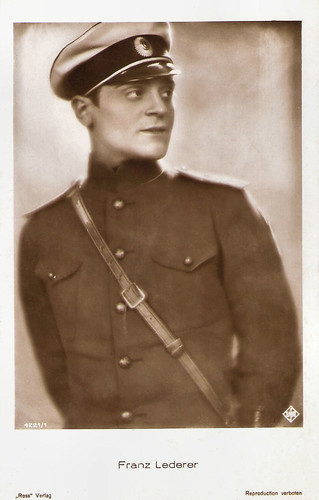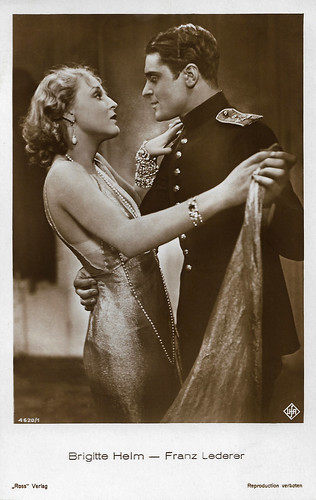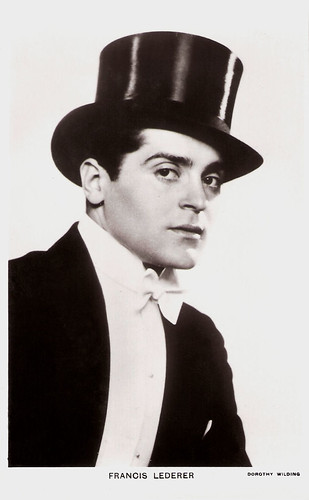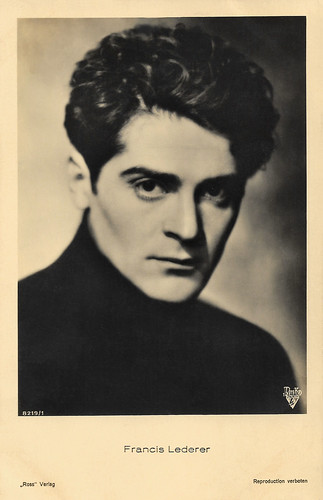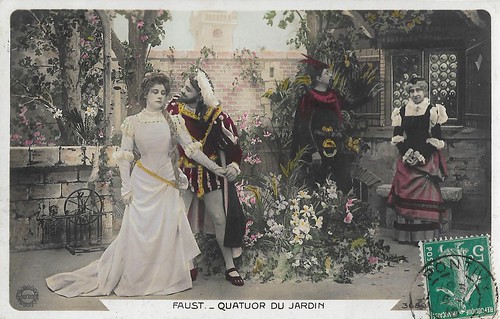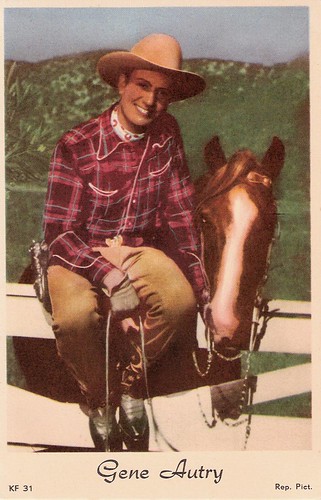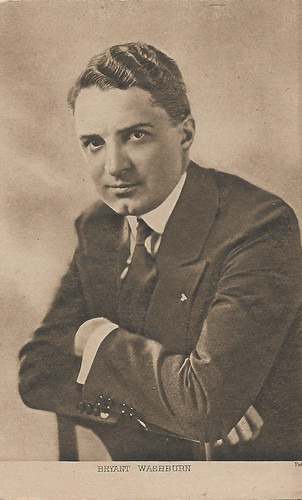For the social melodrama Zuflucht (1928), Henny Porten invited stage actor Franz Lederer to be her co-star. His film debut immediately tuned the handsome Czech actor into a popular film star. Zuflucht/Refuge was produced by Porten's own film company, HPF (Henny Porten-Froelich Produktion GmbH (Berlin)), and directed by Carl Froelich. Froelich staged the film as realistically as possible by shooting in the quarters of workers, kitchens, arcades, market halls, and third-class hospitals. The cast also included Max Maximilian, Margarete Kupfer, Alice Hechy and Carl de Vogt.
![Henny Porten and Franz Lederer in Zuflucht (1928)]()
German postcard by Ross Verlag, no. 100/1. Photo: Alex. Schmoll / HPF (Henny Porten-Froelich Produktion GmbH (Berlin)). Henny Porten and Franz Lederer in Zufluch/tRefuge (Carl Froelich, 1928).
![Henny Porten and Franz Lederer in Zuflucht (1928)]()
German postcard by Ross Verlag, no. 100/2. Photo: Alex. Schmoll / HPF (HPF (Henny Porten-Froelich Produktion GmbH (Berlin)). Henny Porten and Franz Lederer in Zuflucht/Refuge (Carl Froelich, 1928).
![Henny Porten in Zuflucht]()
German postcard by Ross Verlag, no. 110/3. Photo: Alex. Schmoll, Berlin / HPF (Henny Porten-Froelich Produktion GmbH (Berlin)). Henny Porten in Zuflucht/Refuge (Carl Froelich, 1928).
In Zuflucht/Refuge, Franz Lederer plays Martin, who has to flee Germany because of his involvement in the November Revolution. Eight years later, he returns to Berlin. The market vendor Hannelore (Henny Porten) offers him shelter in her apartment, whereupon both fall in love. Martin soon finds work in the construction of the north-south subway through the Tempelhof field, but collapses one day. The pregnant Hannelore cares for the seriously ill Martin.
Hal Erickson writes at AllMovie: "Best known for her comedy roles, Henny Porten went dramatic big-time in her 1928 vehicle Zufflucht [sic] (Refuge). Since Porten also produced the film, she bore the brunt of the criticism, which was far from kind. Many felt that the actress would have been better off sticking to comedy, while others were of the opinion that she was too old for her role (she was all of 40 at the time). The most positive comments were reserved for Porten's incredibly good-looking leading man, Francis Lederer. In fact, Zufflucht represented Lederer's screen debut, a full year before his 'official' cinematic bow in Pabst's Pandora's Box."
However, the film was positively received by some of the German critics at the time. The Berliner Lokal-Anzeiger reviewed the film on 1 September 1928: "The fact is that this simple story became a wonderful film, and indeed a tangible step forward in the field of German film in general - thanks not only to the exquisite portrayal, but above all to the direction of the film. Carl Froelich has had the courage to openly show what he has learned from the New Russian film art. [...]
There is hardly any tradition here, there is no bashful make-up, nothing and nobody is made 'cute' - yes, the outstanding Henny Porten does not even shy away from turning into a self-denying Cinderella. That sounds hard, but it means liberation from the traditional teasing fuss of numerous film divas, numerous directors. [...] The film is a ray of hope. "
Critic Hanns Horkheimer added in Berliner Tageblatt on 2 September 1928: "The good role of her Hanne is raised to all-human validity, when this joyless market maid awakens to motherly-loving sacrifice, when she, the tormented, with two powerful arms, makes a new life for the strayed, and then when the short spring is full of warmth and heat Promise on the deathbed of the selfless lover forever vanishes. This lover is Franz Lederer, [...] as a film debutant of the antics of Russian film actors. Naturalistic life and experience are raised by him through creative skill into that sphere in which there are no bravura details, but only a self-evident whole. The management of the again tactically, technically and figuratively very hard-working and skillful Carl Froelich contributed the rest to the success."
![Henny Porten in Zuflucht]()
German postcard by Ross Verlag, no. 110/4. Photo: Alex. Schmoll, Berlin / HPF (Henny Porten-Froelich Produktion GmbH (Berlin)). Henny Porten in Zuflucht/Refuge (Carl Froelich, 1928).
![Henny Porten in Zuflucht]()
German postcard by Ross Verlag, no. 110/5. Photo: Alex. Schmoll, Berlin / HPF (Henny Porten-Froelich Produktion GmbH (Berlin)). Henny Porten in Zuflucht/Refuge (Carl Froelich, 1928).
![Margarete Kupfer in Zuflucht (1928)]()
German collectors card by Ross Verlag in the series Vom Werden deutscher Filmkunst - Der Stumme Film, picture no. 198, group 43. Photo: HPF (Henny Porten-Froelich Produktion GmbH (Berlin)). Publicity still for Zuflucht/Refuge (Carl Froelich, 1928).
German actress Margarete Kupfer (1881-1953) was an extremely versatile and prolific character player in classic silent films directed by Friedrich Wilhelm Murnau, Paul Leni and Ernst Lubitsch.
Sources: Hal Erickson (AllMovie), Wikipedia (German) and IMDb.

German postcard by Ross Verlag, no. 100/1. Photo: Alex. Schmoll / HPF (Henny Porten-Froelich Produktion GmbH (Berlin)). Henny Porten and Franz Lederer in Zufluch/tRefuge (Carl Froelich, 1928).

German postcard by Ross Verlag, no. 100/2. Photo: Alex. Schmoll / HPF (HPF (Henny Porten-Froelich Produktion GmbH (Berlin)). Henny Porten and Franz Lederer in Zuflucht/Refuge (Carl Froelich, 1928).

German postcard by Ross Verlag, no. 110/3. Photo: Alex. Schmoll, Berlin / HPF (Henny Porten-Froelich Produktion GmbH (Berlin)). Henny Porten in Zuflucht/Refuge (Carl Froelich, 1928).
A ray of hope
In Zuflucht/Refuge, Franz Lederer plays Martin, who has to flee Germany because of his involvement in the November Revolution. Eight years later, he returns to Berlin. The market vendor Hannelore (Henny Porten) offers him shelter in her apartment, whereupon both fall in love. Martin soon finds work in the construction of the north-south subway through the Tempelhof field, but collapses one day. The pregnant Hannelore cares for the seriously ill Martin.
Hal Erickson writes at AllMovie: "Best known for her comedy roles, Henny Porten went dramatic big-time in her 1928 vehicle Zufflucht [sic] (Refuge). Since Porten also produced the film, she bore the brunt of the criticism, which was far from kind. Many felt that the actress would have been better off sticking to comedy, while others were of the opinion that she was too old for her role (she was all of 40 at the time). The most positive comments were reserved for Porten's incredibly good-looking leading man, Francis Lederer. In fact, Zufflucht represented Lederer's screen debut, a full year before his 'official' cinematic bow in Pabst's Pandora's Box."
However, the film was positively received by some of the German critics at the time. The Berliner Lokal-Anzeiger reviewed the film on 1 September 1928: "The fact is that this simple story became a wonderful film, and indeed a tangible step forward in the field of German film in general - thanks not only to the exquisite portrayal, but above all to the direction of the film. Carl Froelich has had the courage to openly show what he has learned from the New Russian film art. [...]
There is hardly any tradition here, there is no bashful make-up, nothing and nobody is made 'cute' - yes, the outstanding Henny Porten does not even shy away from turning into a self-denying Cinderella. That sounds hard, but it means liberation from the traditional teasing fuss of numerous film divas, numerous directors. [...] The film is a ray of hope. "
Critic Hanns Horkheimer added in Berliner Tageblatt on 2 September 1928: "The good role of her Hanne is raised to all-human validity, when this joyless market maid awakens to motherly-loving sacrifice, when she, the tormented, with two powerful arms, makes a new life for the strayed, and then when the short spring is full of warmth and heat Promise on the deathbed of the selfless lover forever vanishes. This lover is Franz Lederer, [...] as a film debutant of the antics of Russian film actors. Naturalistic life and experience are raised by him through creative skill into that sphere in which there are no bravura details, but only a self-evident whole. The management of the again tactically, technically and figuratively very hard-working and skillful Carl Froelich contributed the rest to the success."

German postcard by Ross Verlag, no. 110/4. Photo: Alex. Schmoll, Berlin / HPF (Henny Porten-Froelich Produktion GmbH (Berlin)). Henny Porten in Zuflucht/Refuge (Carl Froelich, 1928).

German postcard by Ross Verlag, no. 110/5. Photo: Alex. Schmoll, Berlin / HPF (Henny Porten-Froelich Produktion GmbH (Berlin)). Henny Porten in Zuflucht/Refuge (Carl Froelich, 1928).

German collectors card by Ross Verlag in the series Vom Werden deutscher Filmkunst - Der Stumme Film, picture no. 198, group 43. Photo: HPF (Henny Porten-Froelich Produktion GmbH (Berlin)). Publicity still for Zuflucht/Refuge (Carl Froelich, 1928).
German actress Margarete Kupfer (1881-1953) was an extremely versatile and prolific character player in classic silent films directed by Friedrich Wilhelm Murnau, Paul Leni and Ernst Lubitsch.
Sources: Hal Erickson (AllMovie), Wikipedia (German) and IMDb.









